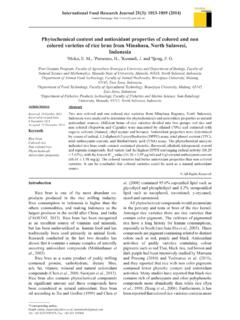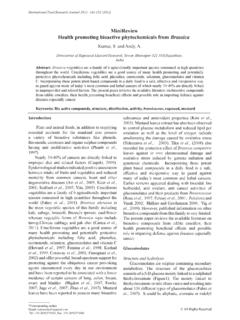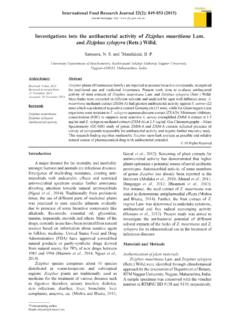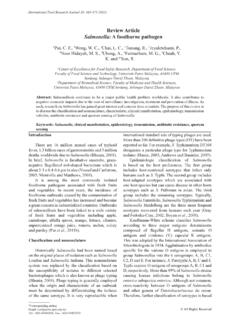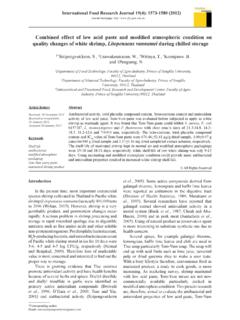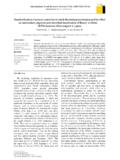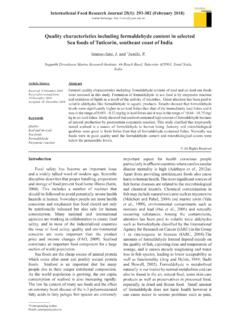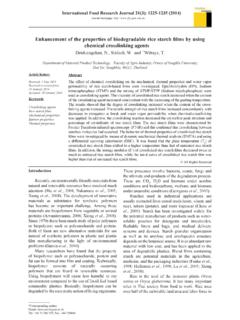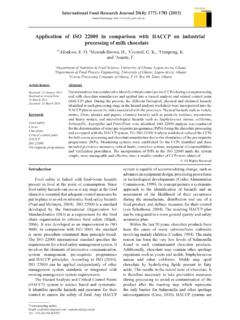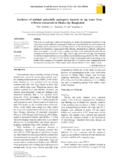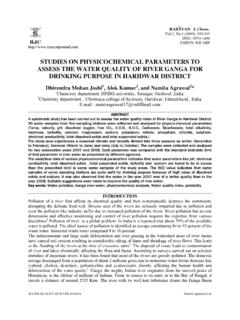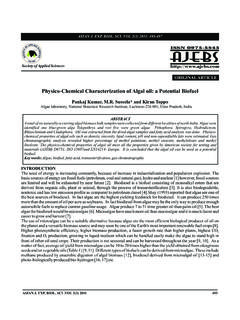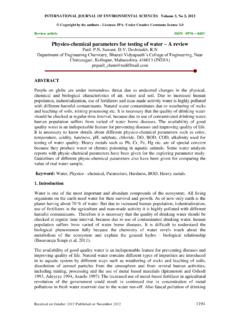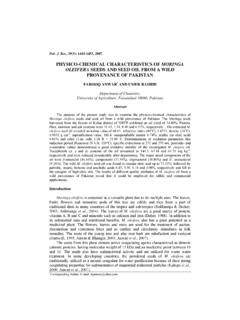Transcription of Evaluation of effectiveness of three cellulose derivative ...
1 All Rights Reserved*Corresponding author. Email: Food Research Journal 18(4): 1381-1386 (2011)1 Jafarizadeh Malmiri, H., 1*Osman, A., 2 Tan, and 2 Abdul Rahman, of Food Science, Faculty of Food Science and Technology, Universiti Putra Malaysia, 43400 UPM, Serdang, Selangor, Malaysia2 Department of Food Technology, Faculty of Food Science and Technology, Universiti Putra Malaysia, 43400 UPM, Serdang, Selangor, MalaysiaEvaluation of effectiveness of three cellulose derivative -based edible coatings on changes of physico-chemical characteristics of Berangan banana (Musa sapientum cv.)
2 Berangan) during storage at ambient conditionsAbstract: three edible coating formulations, namely methyl cellulose (MC)-glycerol, sodium carboxymethyl cellulose (Na-CMC) - glycerol and hydroxypropylmethyl cellulose (HPMC) - stearic acid-glycerol with three concentrations of main edible components, MC (2, and 5% w/v), Na CMC ( , and w/v) and HPMC (2, 4 and 6% w/v) were applied on the peel surface of green mature Berangan banana and stored at 26 2 C and 40-50% relative humidity.
3 Results showed that coated banana using high concentration ( w/v) of Na-CMC and 1% (w/v) glycerol had the least weight loss, total colour difference and total soluble solids content ( , and Brix, respectively) and had the highest firmness and pH ( N and ) at day 10 of storage while the control samples were already completely ripened. This was followed by banana coated with low concentrations of Na-CMC ( w/v)-glycerol (1% w/v) and HPMC (2% w/v)-stearic acid (1% w/v)-glycerol (1% w/v), MC and control.
4 However, no significant difference was observed between banana coated with low concentration of MC (2% w/v)-glycerol ( w/v) and : Edible coating, Berangan banana, sodium carboxymethyl cellulose , methylcellulose, hydroxypropylmethyl cellulose , quality characteristicsIntroductionEdible coatings applied on fresh fruits to reduce the moisture transfer, oxidation, metabolic processes, respiration rate, physical/mechanical impacts and microbial growth and to maintain the sensory quality and safety are important to prolong their shelf-life (Nisperos-Carriedo et al.)
5 , 1992). Edible coating acts as a physical barrier for the gas exchange between the fruit and their storage environment and create modified atmosphere. It slows down both the rates of generating energy and substrate degradation which in turn will slow down the biochemical reactions leading to fruit ripening (Maftoonazad and Ramaswamy, 2005). The polysaccharides as coating materials for fruits have been used extensively in the past few years. These natural polymers, in addition to the above mentioned benefits, present advantages due to their availability, low cost, and biodegradability.
6 The latter in particular is of great interest, as it leads to a reduction in the large quantities of non-biodegradable synthetic packaging materials (Zhou et al., 2008). In addition, their physico-chemical properties can also be improved by modifying is a naturally occurring polymer which is found abundantly and is usually present as a linear polymer of anhydroglucose (Kester and Fennema, 1986). At a molecular level, cellulose is a simple linear polymer comprising of -[1,4] linked D-glucose molecules.
7 Because of its regular structure and array of hydroxyl groups, it tends to form strong hydrogen-bonded crystalline microfibers, which are insoluble in several solvents (Zugenmaier, 2006).Several cellulose derivatives such as methyl cellulose (MC), carboxymethyl cellulose (CMC), hydroxypropyl cellulose (HPC), and hydroxypropylmethyl cellulose (HPMC) are widely produced commercially (Olivas and Barbosa-Canovas, 2005). These edible coatings have been applied to a variety of fruits to provide moisture, oxygen and carbon dioxide barriers, and to improve adhesion of coating formulations (Kester and Fennema, 1986).
8 Coatings and films that are based on these cellulose ethers are generally transparent, flexible, odourless, tasteless, water-soluble, and resistant to O2 and CO2 (Nisperos-Carriedo et al., 1992).Edible coatings based on cellulose derivatives have also been used to delay ripening in some climacteric fruits like mango, papaya and avocado. Baldwin et al. (1999) used an edible coating based on HPC on mango and reported that it could delay ripening and increased concentrations of flavour 1382 Jafarizadeh Malmiri, H.
9 , Osman, A., Tan, and Abdul Rahman, Food Research Journal 18(4): 1381-1386volatiles of mango. The application of CMC sodium salt (Na CMC) coating was also found able to delay ripening of mango up to 32 days at 13 C and 85% RH (Carrillo-Lopez et al., 2000). Coating treatments based on CMC sodium salt extended storage life of pineapple fruit up to 5 weeks at 10 C and 90-95% RH, whereas the control fruit had a storage life of only 28 days (Nimitkeatkai et al., 2006). Maftoonazad and Ramaswamy (2005) applied MC coating on avocado.
10 Their results indicated the strong effects of the coating in retarding the ripening behaviour of coated avocados as compared to control samples, at ambient fruit is climacteric and ripens rapidly after harvest. As reported by Marriott (1980), ripening of banana is associated with peel colour change from green to yellow, hydrolysis of starch to simple sugars, softening of the pulp and development of aroma. Banana has short storage life in ambient temperature (25 - 35 C) and it is usually harvested at mature green stage and stored (Stewart et al.)
